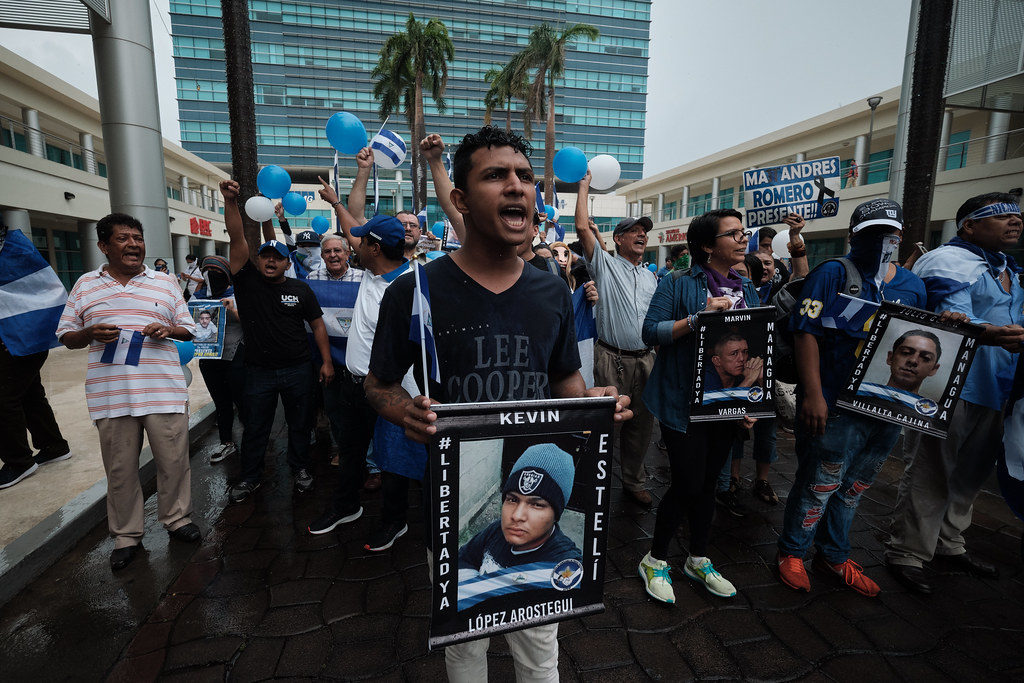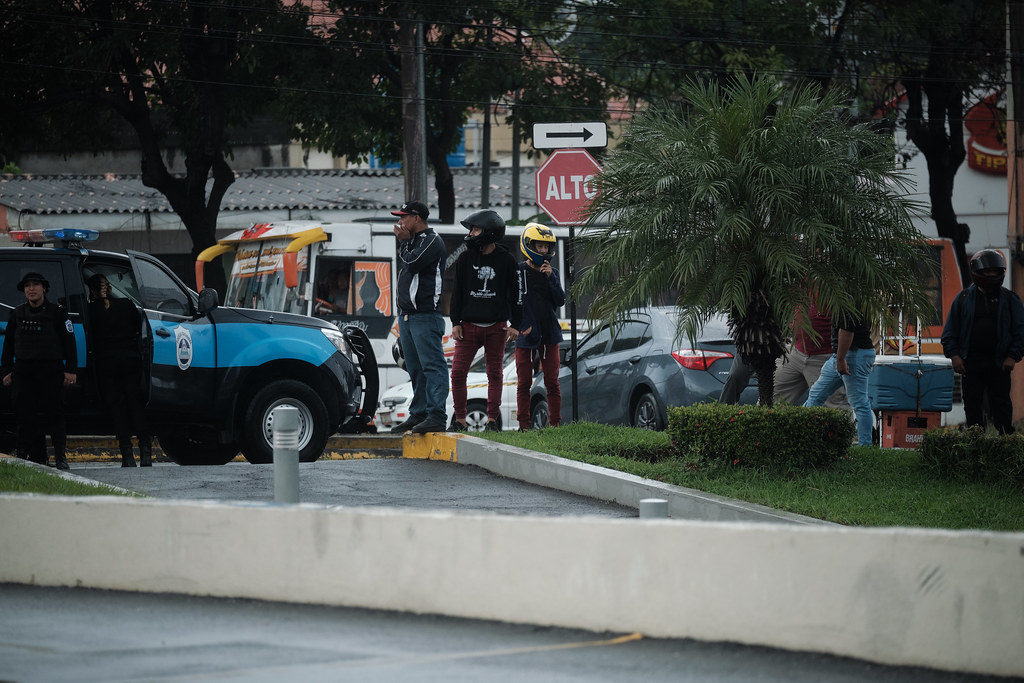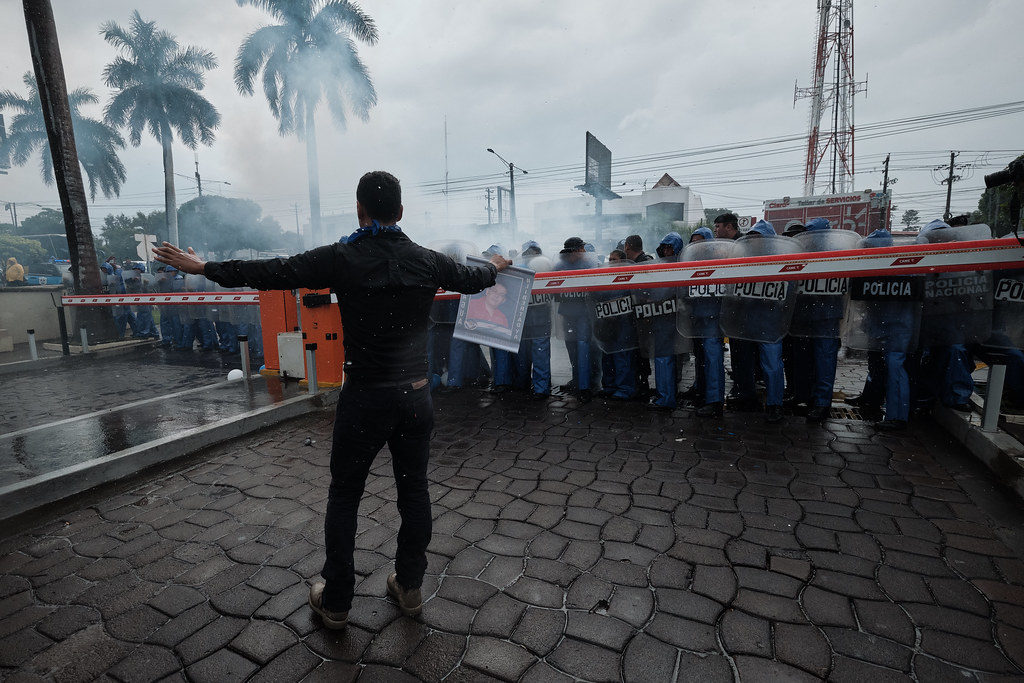The Latest Protests in Managua Challenged the Ortega Police State
The government deployed hundreds of riot police and paramilitaries in Managua

Neither the rain nor the Police managed to cancel the opposition call, which mutated from a march to four sit-ins in Managua
By Franklin Villavicencio (Confidencial)
HAVANA TIMES – They arrived prepared, coordinated and ready. The majority were certain that they would not advance a kilometer from the four points where the march would start. And, indeed, so it was. On Saturday, September 21, Managua woke up militarized with hundreds of agents, patrols and paramilitaries—who operate in complicity with the authorities.
But the de facto state of siege imposed by the Ortega dictatorship, precisely a year ago, was outwitted once again. Rain poured heavy on the streets, but the call to protest wasn’t canceled. There is no march, but there are pickets and sit-ins that make the police deployment on the “Carretera” (road) to Masaya, one of the main arteries of Managua seem absurd.
Magdalena evaded an intimidating cordon of policemen, who were stationed in front of the Centro Pellas building, on the road to Masaya. They didn’t even know they were outwitted. Her 21- year-old daughter had told her to go to the protest, and if not, she would go alone. Magdalena, 59, and her daughter took two buses and arrived from the San Judas neighborhood, six kilometers from where the demonstrations were set to be held.
The short woman in a long skirt, and with the skin burned by the sun, jumps over a small half meter high wall, while with an intimidating face about a hundred riot police observe her unaffected. They remain like gargoyles, without moving. Behind them is Commissioner Valle Valle, coordinating the operation. After jumping the fence, Magdalena and her daughter run to the entrance of the building, where some 80 protesters shout jubilantly.
Perhaps Magdalena is unaware of the symbolic act she has just done and that summarizes the activities of this day. She, a woman who has come from one extreme of the capital to inflate a pair of blue and white balloons and take out from the bottom of her purse—very folded—a scarf with the colors of the Nicaraguan flag.
That is the first thing she does. She is nervous. She looks for two balls of almost undone napkins deep inside her purse. She unwraps them and extracts four uninflated balloons. She gives two to her daughter and she puts two between her lips. It seems that there are forbidden things in her bag. And the truth is that in Nicaragua they are prohibited. Taking them out on the streets has already caused other protesters to spend an afternoon, a night, or even months in the country’s jails.
“I will not deny that I was afraid,” she replies when asked about the feat she has just done, “but it is worse to continue living in a dictatorship.”
The balloons are filled with air and the blue and white scarf is placed on one hand. She joins the group of protesters shouting slogans and remain in expectation at any escalation of repression.
Injured by Police
At this time, a little after 11, they had already hurt a boy. Pedro Estrada, a former political prisoner who had been at the National Autonomous University of Nicaragua (UNAN) occupation, was hit in his forehead with a stun grenade canister that exploded after being thrown by an officer. The 21-year-old man was helped by a group of protesters who moved him indoors and wrapped his head to mitigate the bleeding. A lady fainted, but her condition was not serious.

The sound of broken glass makes the group of protesters seek refuge on one side of the building. The police contingent had launched a marble that hit one of the glass façade windows of the building. It is not the first window that the Police break from this complex, a symbol of big capital. This financial center has been the epicenter of pickets and sit-ins since the beginning of the April civic rebellion in 2018. Their workers leave occasionally at lunchtime with blue and white flags, and challenge the regime from the parking lot.
But this time the besiegement has been more brutal. All accesses to the building remain closed, as are its surrounding streets. It seemed that some drug lord is taking refuge inside, or a jihadist terrorist that the police want to capture. That is how brutal the deployment is. But inside there are only some eighty persons who do not even have mortars. Inside there are university students and ladies like Magdalena, who fed up with oppression made it there by bus through militarized streets, or pass in the face of uniformed agents, paramilitaries and officers armed with AK-47 rifles.
“Knowing that there were people coming, we couldn’t stay at home. We couldn’t,” she said, without hesitation.
On September 23, 2018, the dictatorship of Daniel Ortega crushed one of the last large civic demonstrations before its ban (on marches) was issued on the 28th of that month. Magdalena remembers that day. Like today, she also left her home with her daughter. She said that one of the things that prompted her to come here was remembering young Matt Romero, one of the last victims of repression and for whose memory she protested on Saturday. On this occasion there were no deaths or detainees.

Four sit-ins, four points
About fifteen police patrols of the regime full of agents come and go along the road. They are assigned to cover a radius between the offices of Movistar, the Centroamerica roundabout and the Centro Pellas. Throughout this distance there are four outbreaks of protests, four small groups—compared to the April 2018 demonstrations, but big enough to make noise and put hundreds of policemen running throughout the capital.
In Plaza Vistana, near the Centroamerica roundabout, in the parking lot of the Rostipollo restaurant—in front of the National Lottery—next to the Movistar building and in the Centro Pellas, groups of demonstrators shouted slogans. They were already clear that if they could not advance the kilometers of the march, they would stay there, shouting and waving flags.
This is a new modality of simultaneous protest carried out twice before. The coordination, on this occasion, made the difference. Each group of protesters took a point, and did not move from there. On the one hand were the members of the Blue and White National Unity, on the other the Civic Alliance for Justice and Democracy, on the other the students, and on one more the former political prisoners.
They looked surrounded and expectant. The regime believed that it had isolated them, without knowing that this was part of the strategy. The march was foiled, but the opposition also thwarted the “state of siege” of the dictatorship.





